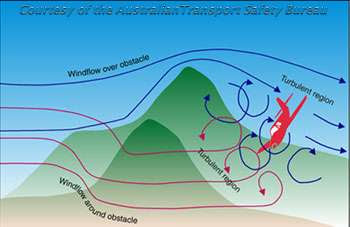Knowing that many fires out west are in or near mountainous terrain, I got interested in learning more about winds and turbulence that occur in mountains and how they affect aviation interests. I went first to one of my general aviation books -- The Complete Pilot by Bob Gardner. Here I read about what is known as mechanical turbulence. If I understand mechanical turbulence correctly, mechanical turbulence occurs when a building or a mountain disturbs that the flow of the wind current, sometimes creating strong downslope winds on the lee side of the building or mountain. These winds are also known as down drafts or bad air. Strong down drafts (see the picture above) can have more down power than airplanes have climb power. A pilot caught in such a down draft may not be able to fly out of the downdraft.
The picture below illustrates something known as rotor winds, a pilot unfortunate enough to tangle with these winds is flying into winds that are likely to overpower an aircraft with often fatal consequences.
There have been fatal tanker crashes while flying fires where down drafts and/or rotor winds may have been a major factor in the crash including a fatal crash out west in the late 1990s and one or two fatal crashes in the 1970s (also out west).
Wind and turbulent conditions can be forecast by meteorologists. Strong winds and bad turbulence including but not limited to rotors and down drafts are dangerous to all aviation interests, including aerial firefighting operations, leading to grounding of aerial fire fighting operations. So, if you are living near a wildfire AND the winds are strong AND you don’t see tankers and helicopters making retardant or water/foam drops on the fire there is a reason. They are not flying because it is not safe to do so.
REFERENCES
For more information about mountain wave turbulence, please go to this web page from the Australian Transport Safety Bureau, they are the source of the images that I have included here. I like that document, not only for the wonderful graphics but for a short and succinct explanation of mountain wave turbulence. While written for the Australian audience, I certainly got a lot out of it. Sparky Imeson, who wrote a book about mountain flying writes about mountain waves and rotor winds here. Sadly, Sparky died when his plane crashed earlier this year. His family is keeping up his web page on mountain flying. He has numerous articles on many other subjects related to mountain flying and I highly recommend them. If I am correct, I believe he gave presentations on mountain flying at training sessions for air tanker pilots. I myself have spent at least a couple of hours on his website, and find myself frequently referring to it.



No comments:
Post a Comment